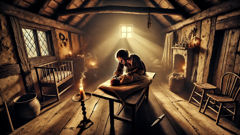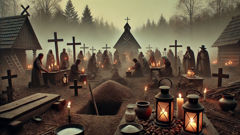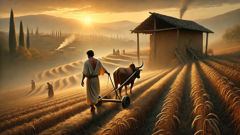Introduction
They said the Strzyga was born between two heartbeats. In the long houses that stitched together the villages of the Polish lowlands, midwives whispered of children who arrived with a second shadow folded into their ribs, as if a human life had been double-seeded and could not be made whole. The old language had a dozen words for hauntings, but Strzyga meant something narrower and colder: a person who carries two souls, one that belongs to the living and another that lingers with hunger. This hunger did not speak of bread and beer but of warm blood and the soft surrender of breath. To hear the tale of a Strzyga was to step into a narrow, wind-scoured lane at midnight and follow the echo of wingbeats you could not see; it was to watch a neighbor smile across the threshing floor and imagine the smile turning like a trap. The legend braided together pre-Christian belief, the fear of infant mortality, and the uneasy manners of a community hemmed in by forest and church. Priests wrote charters against the old words, but the stories survived in kitchen smoke and under the lids of coal-black hearths, where elders recited the names of wards and the secrets to stopping a revenant. For those who would learn, this is the tale of how a Strzyga takes form, how villages trembled under its presence, and the desperate, sometimes brutal, means people used to protect the living. Read carefully: the Strzyga is not merely a monster; she is a mirror of human failure and superstition, a testament to how a community chooses to live when the border between life and death thins to a reed.
Origins: Twins Between Breath and Bone
The story of the Strzyga begins in the places where the forest presses close to the village and the trees remember names older than the parish register. Long before the rectangular pews and Latin prayers, people spoke to the land with a vocabulary that admitted spirits as everyday company. Children could be born with a mark, a second tooth, or an unusual stillness that set them apart; sometimes that stillness was a sign of blessing, sometimes of otherness. The Strzyga belonged to the latter kind of sign: an anomaly explained by ritual, blamed when the unexplained took a life.

In many accounts the Strzyga is female—though not always—and her origin is traced to those births that midwives called "doubled." Two hearts, two souls, a mouth that once drew twin breaths at the same delivery: such births were rare and feared. Folk doctors claimed the second soul was the remainder of a twin who had failed to form, fragile and resentful. Others said a Strzyga might arise when a mother set her eyes upon an unbaptized infant with sorrow in her throat, or when a death hung in the house like a bad smell and infected newborns with revenant hunger. The language around the Strzyga is regional and elastic; in some valleys she is called striga, in others ostrzyga, but the core belief remains: there exists a human who can step outside themselves and feed on the quick warmth of life.
These explanations carried weight in communities where infant mortality and unexplained illnesses were frequent. When a child with the mark grew, people watched for signs: an aversion to church bells, sudden pallor, a smile that arrived too late after someone nearby had grown weak. Night terrors and sleepwalking were not merely behavioral curiosities but evidence: the Strzyga crawled from the body under the moon and took wing. In one telling, the dual soul meant the Strzyga could split—one half sleeping in the bed, the other leaving like a skin to stalk livestock, strangle infants, or drain travelers. The frightening image is almost domestic, because the predator lived in the circle of kinship: a cousin, a wife, a fosterchild. This proximity made the belief more than a story; it was an explanation for grief that otherwise had no edges.
The Christianization of Central Europe layered new rituals over older anxieties. The Church could not countenance souls in multiplicity, so priests categorized Strzyga belief as superstition and a moral risk. Yet the Church also offered techniques that the villagers used pragmatically: baptismal names, prayers, and consecrated objects. Sometimes priests refused to perform rites thought to encourage revenants by acknowledging the second soul. At other times, clergy acquiesced to local custom, allowing amulets or symbolic burnings to give survivors something they could do against fate. This uneasy alliance between doctrine and practice produced a hybrid folklore: crosses painted over thresholds yet charms hung from rafter beams; Latin exorcisms and gatherings around the hearth where elders recited recipes for survival. These hybrid rituals were also a kind of cultural insurance, a way to pull a community together around a common enemy.
To understand the Strzyga, it helps to look at the sociological logic: in isolated agrarian societies, where kinship confers both sustenance and risk, a framework that identified an internal source of danger could be stabilizing. Naming the evil—declaring that one person might become a Strzyga—gave neighbors a narrative for loss and a set of actions to protect the rest. The rituals that followed did more than remove a supposed threat; they reaffirmed communal bonds. But they also introduced cruelty. Allegations could turn neighbor against neighbor. The fear of the Strzyga could justify reprehensible acts: isolation, mutilation, or death. The legend, therefore, lives at the intersection of cultural survival and moral peril.
Stories of the Strzyga often include the helplessness of technology and the resourcefulness of folk medicine. Folk healers prepared mixtures of salt and ash and advised burying newborns with a knife worn beneath the pillow, or tying iron to the cradle—iron as a barrier against wandering spirits. Some families placed a mirror under the crib, a pagan attempt to reflect away the double self. Others relied on more violent traditions: a suspected Strzyga might be exhumed after a relative's sudden death to see whether the corpse had the signs of vampiric life—untouched hair, fresh blood at the mouth, an unconsecrated look about it—and then be burned or otherwise destroyed. These practices were brutal but understandable within the logic of a world that prized immediate solutions to existential threats.
It is crucial, too, to note the gendered dimension. Most tales center on women who become Strzygi—widows, abandoned mothers, girls marked at birth. In a society where women's bodies were closely policed, the idea of a woman harboring a second, malicious soul fit anxieties about fertility, inheritance, and social order. A woman accused of being a Strzyga threatened more than life; she threatened the rules around marriage, dowry, and kinship that held village life together. Folklorists who study these legends see in them a map of power: who gets to speak, who is listened to, and how communities respond when the life-course of children and elders diverges unexpectedly.
Yet some stories invert the cruelty and give us complicating mercy. A Strzyga sometimes was a protective figure in contradictory tales: a woman who kept the village from worse spirits by eating the sickness before it spread, or who took a little of children's vitality and left them to live. These ambiguous narratives reveal something important: the Strzyga is not a one-dimensional villain but a cultural container for contradictions—care and harm, family and exile. In every telling, the listener must decide where blame lands. Is the Strzyga born monstrous, or is she shaped into one by fear? The legend does not provide easy answers, but it insists on being listened to carefully, because names and stories have consequences for how people treat one another.
Across valleys and time, the Strzyga also intersects with other Slavic revenant figures: the vampiric upir, the restless dusk-dweller, the soul-taker. Each region mattress-stitches the creature to local concerns. In some southern Polish retellings, the Strzyga is keen on the blood of children; in northern versions she prefers the necks of unmarried men wandering by the millpond. The core constant is the doubling and the nighttime roaming. Whether the Strzyga becomes a bat, a falcon, or a thin smoke that slips through shutters depends less on consistent doctrine and more on the teller's need for a particular image to make the fear feel immediate.
Language matters in these tales. The words used to describe the Strzyga are often blunt and tactile: "gnawing," "suction," "cold breath." The imagery is corporeal because the legends arose where hunger was literal and death commonly sudden. Lists of preventative measures, recorded by ethnographers in the nineteenth century, include straightforward instructions that look macabre today: if you suspect a neighbor is a Strzyga, nail their coffin shut, decapitate the corpse, place acorns in the mouth, or burn the body. Such methods are recorded with a kind of anthropological dispassion that hides the moral weight they carried in village life. The point is not to pass judgment on those who took these steps but to see how a community will seize any available tool when mortal peril looks like the next sunrise.
In the end, the origin story of the Strzyga is a story about boundary: between living and dead, between acceptance and exile, between the village's care and its capacity for cruelty. The legend stayed alive because it answered pressing, terrible questions. When a household lost children or a traveler went missing by the river, naming the cause allowed people to act, for better or worse. The Strzyga is thus a dark ledger of human fear, resourcefulness, and the ways we make monsters to make sense of sorrow.
Hunting the Strzyga: Rituals, Trials, and the Price of Fear
If the Strzyga is born as a doubled soul, then hunting it becomes a social technology: a set of shared rituals by which adults tried to sever the extra soul from the community. Hunting a Strzyga did not look like a heroic trek in armor; it was quieter, cozier even, until the moment it stopped being so. At first the village attempted soft measures. They lit extra fires and kept doors open at night to let the household spirits know who truly belonged. Herbs were burned: rosemary, juniper, wormwood. Salt lines were laid beneath thresholds and across children's cots. Mirrors, silver, and iron were trusted materials—symbols that cut across various traditions because each had a cultural logic. Mirrors could reflect the doubled soul back into the body; iron, as a gift of metal made by human hands, disturbed spirits tethered to older, wilder forces.

When these precautions failed or the pattern of losses grew, the community escalated. Stories accumulate details of how suspicion migrates from the unusual to the condemned. A family might notice that after a night of particularly bright moon, pigs were unbitten but a child grew pale. A neighbor's house saw repeated stillbirths. The rumor would circulate until it thickened past the possibility of denial. At that point village councils met in hushed urgency. Sometimes the suspected person was ostracized—banished from the hearth, fed at the door, given clothing but not a bed. In other cases more violent recipes were chosen: exhumation followed by diagnosis. Burial signs that suggested vampirism—lack of decay around the mouth, apparent fresh clots—would be interpreted as true evidence. Ethnographers of earlier centuries recorded these procedures without sentiment: a corpse's body would be pricked with a needle, and if blood welled, that was confirmation.
The rituals that followed were ritualized justice. Burning the heart, decapitation, impalement through the chest with a stake—each practice is a blunt instrument against fear. In some regions, families placed a heavy stone or scythe across the grave to prevent the corpse from rising. Other measures aimed to trick the revenant: fill a suspected Strzyga's mouth with garlic or place acorns so the revenant would spend hours counting them instead of feeding. These acts, though cruel, were also performances meant to seal communal solidarity; they told people they had acted when they otherwise might have been powerless.
The moral fog around these acts is thick. Often a person became a suspect because of sorrow and envy: a woman whose husband brought home a new bride; a neighbor who prospered when others failed. Economic precarity and social tensions found an outlet in accusation. The Strzyga legend offered a vocabulary for punishment that could be framed as protection. It turned personal grievance into communal ritual, and that transformation made reprisals feel legitimate. Anthropologists caution against simplifying these practices into mere superstition; they are, instead, systems through which communities defend themselves, sometimes at the cost of justice.
Alongside these punitive responses were more compassionate stories. Some elders insisted on kinder interventions: bringing the suspected person before the priest, bathing them in blessed water, performing an extended vigil of prayers and fasting. In the gentler versions, conversion rather than execution saved the accused. The Strzyga sometimes were redeemed in the stories: a woman who had been ostracized returned to humanity after a long fast, confession, and the communal acceptance of her kin. Those tales reflect the community's wish for reconciliation, for mistakes acknowledged and repaired. They serve as a reminder that not every accusation needed to end in blood.
As time passed, the Strzyga legend adapted to new frames of knowledge. When the rationalist age swept through the region, some scholars tried to explain Strzyga reports through disease—rabies, porphyria, and mental illness were all proposed causes. Yet clinical explanations often fail to account for the cultural and symbolic power of the myth: why particular individuals, how rituals served the living, and what the acts meant in social terms. The legend retains its force because it speaks to a deeper set of human anxieties: about bodily boundaries, about the unknown inside those we love, and about the measures communities take to survive collective trauma.
The Strzyga also moved into literature and urban storytelling. Poets in the nineteenth century borrowed the figure as a symbol of social decay and forbidden desire; playwrights staged tales of green-lit forests and trembling maidens; painters rendered the Strzyga half in shadow, half in domestic light. Modern retellings often recast her as a tragic antihero, a being shaped by a world that condemned difference. Contemporary storytellers are drawn to the moral complexity: the Strzyga is not merely a predator but a figure forged from neglect, fear, and the cruelty of forced choices. In this way the legend migrates from parochial worry to universal question: how do we treat those who are different, and at what cost do we defend ourselves?
There are also regional rituals that delight in ingenuity. In one northern valley the community ensures the dead are laid to rest with a scythe across their chest and a brick under their jaw to make rising difficult. In another, suspected Strzygi had to pass a threshold made with three kinds of salt and must recite the names of their ancestors backward; failure meant a family vigil with staff and torch. A particularly arresting motif involves a suspected Strzyga being forced to look into a mirror before dawn; if the second soul is visible, the community has licensed proof. Such rites are as meaningful for their theatricality as for their supposed efficacy: they publicly declare that something has been done and that the living have not simply waited for the next tragedy.
The penalties and trials reveal the human cost of myth. Accusations could end a life—even in cases where the accused took their own life rather than face communal scorn. This grim calculus makes the Strzyga legend a cautionary archive. Folklore here is not content to frighten for entertainment; it instructs communities about the boundaries of blame. It teaches that fear, unexamined, becomes policy, and policy becomes harm. Yet even within its darkness, the tale presses on moral nuance: there are versions in which the community saves itself without destroying the accused, where reason and ritual meet to temper cruelty.
What endures is the Strzyga's haunting image: a neighbor's lullaby turning thin in the throat at midnight, a smell of flowers that masks iron, the soft thud of a body leaving a bed to roam the fields. Modern readers, when they hear the tale, often connect it to the broader myth of the vampire. But the Strzyga is a specifically Polish shadow, made from local language, labor patterns, and the small mercies and brutalities of premodern life. In every telling, what frightens most is not the supernatural itself but the human shape of accusation—and the ease with which fear persuades even the kindest to act with coldness toward one of their own.
Conclusion
The Strzyga legend persists because it names a recurring human predicament: when the boundary between what we know and what we fear becomes thin, we invent a shape to hold our dread. That shape has been cruel and compassionate by turns, justified and abused, feared in one valley and pitied in another. As an artifact of Polish folklore, the Strzyga helps us see how communities processed grief, sickness, and social tension with rituals that sometimes saved and sometimes destroyed. The stories teach caution: to act against a supposed monster without scrutiny risks turning justice into violence. They also teach resourcefulness: in a world with little medical knowledge, folklore offered protocols that brought people together to confront randomness. Today the Strzyga remains a provocative symbol in literature and cultural memory—an ambivalent creature that invites empathy and vigilance. When retold, the legend challenges readers to ask how we treat the outsider and what responsibilities we bear to keep both the living safe and the accused human. The answers are never simple, but the tales endure because they demand that we listen, decide, and choose mercy where possible, remembering that myths, like communities, are made by the very decisions they compel.













